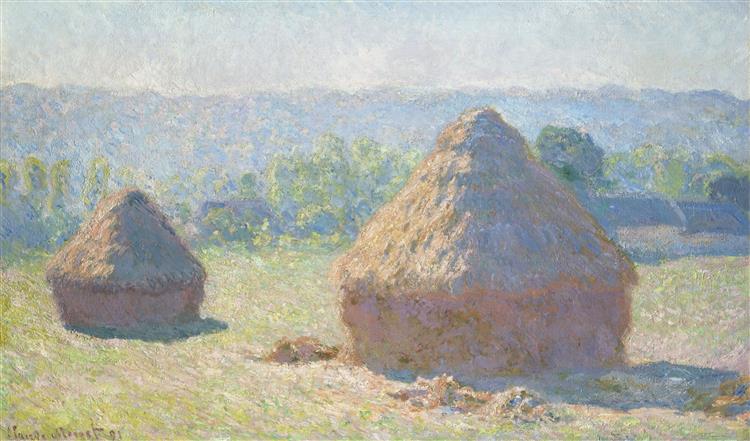Beschrijving
Claude Monet, one of the pillars of Impressionism, offers us in "Haystacks - Late Summer - 1891" a deep contemplation of light and nature through his exploration of the rural landscape. This work is part of a series of canvases dedicated to haystacks, in which the artist captures different moments of the day and weather conditions, exploring how these variables affect our perception of shape and color.
The composition of the painting focuses on a large hay bale on the left, which appears monumental and almost abstract in its form. Monet uses a close approach to the bale, which is a macrocosm of textures and shapes, making it the undisputed protagonist of the work. The hues of the bale, a mix of yellows, golds and ochre tones, delicately intertwine with the green and blue painted background. This tonal choice suggests not only the end of summer, but also the inevitable transition to autumn, where the richness of the harvest begins to fade.
The use of colour in this painting is masterful. Monet applies his well-known technique of loose, rapid brushstrokes, allowing the light to appear to vibrate across the surface of the canvas. The subtle nuances he uses suggest changing lighting and create an almost ethereal atmosphere. This play of light and shadow not only provides volume to the forms, but also suggests a certain transience of time, a recurring theme in Monet's work.
Although the work does not include any visible human figures, the tacit presence of the men and women who might have harvested this hay is felt through the context offered by the landscape. The hay bale undoubtedly points to agricultural labor and man's connection to the land, a vision that Monet deeply understood. Through his brushstrokes, he invites us to reflect on the work behind each harvest and the cycle of rural life.
Monet doesn't just capture a glimpse of nature, he makes an emotional connection with the viewer, evoking memories of life in the countryside. This focus on the agrarian landscape relates to many of his other works, where Impressism is able to highlight the beauty of the everyday through vibrant colours and changing light. Paintings such as "The Water Lilies" or "Rouen Cathedral" share this same focus of exploring light and its effect on the natural environment.
The Haystacks series is an example of how Monet works with thematic repetition to investigate variations in colour and light, a distinctive feature of his style. Each painting in this series allows the same motif to be appreciated under different conditions, emphasising his artistic curiosity and his desire to capture the essence of an ephemeral moment.
In conclusion, "Haystacks - Late Summer - 1891" is a work that transcends the simple portrait of a rural landscape, becoming a meditation on the changing of the seasons and the impermanence of time. Monet presents us with a poetic and luminous vision of life, inviting us to appreciate the ephemeral beauty that surrounds us. His mastery of light, color and form, combined with a deep sense of nature, make this painting a fundamental piece in the history of art and a testament to Monet's enduring legacy as a master of Impressionism.
KUADROS ©, a famous painting on your wall.
Hand-made oil painting reproductions, with the quality of professional artists and the distinctive seal of KUADROS ©.
Painting reproduction service with satisfaction guarantee. If you are not completely satisfied with the replica of your painting, we will refund 100% of your money.

